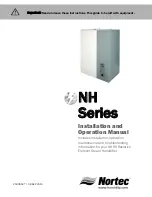
GETTING
ST
AR
TED
The installer should review these points with the homeowner and answer any questions they have before leaving
the job site.
• Achieving Humidity Setpoint.
It may take up to a week of continuous operation to achieve the humidity
setpoint, especially if the home is dry when the humidifier is installed. This also depends on such factors as
weather, size of home, furnishings in the home, and insulation.
• Ideal Humidity.
Home building industry experts cite 35% relative humidity as ideal for comfort and
safeguarding the home during the typical dry season. Homeowners can adjust to their own comfort or until
there is condensation on the windows. Lower the setpoint if condensation appears.
• Unit Not Humidifying.
If the humidifier is not running but the humidity is below the setpoint, the humidity
control may have a frost protection setting to prevent window condensation from appearing.
• Home Ventilation.
Excessive ventilation sends moist air outside and replaces it with dry air. This can make it
hard to maintain the humidity setpoint. If installing a ventilator, use a solution that retains moisture. An Energy
Recovery Ventilator (ERV) is recommended.
• Cleaning Requirements.
At least once per year it is recommended to change the humidifier pad and clean
the water trays of the humidifier. See Operation and Service section for details.
• Energy Consumption.
It is important to explain that with any humidification solution there is a cost
associated with converting water to humidity. The humidifier utilizes the air heat and air flow in your ducting to
make this conversion, which has gas and/or electric costs that depend on your HVAC system type and setup.
What to Expect From Your Humidifier
Humidifier 69-2413EF—09
3






































